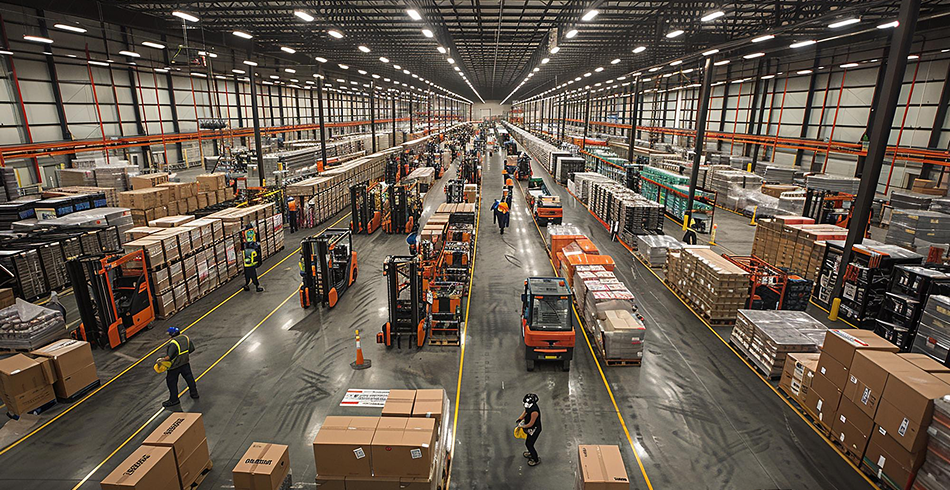The Great Indian Festive Surge: Managing Peak Demand in Warehousing

Why India’s FMCG & Retail Supply Chains Rise or Fall on Warehouses
Every September, something subtle but seismic begins to stir in India. Lights appear in shop windows. E-commerce platforms quietly prime their servers. Families begin to draw up shopping lists. And somewhere far from the storefronts, in cavernous warehouses, the blueprints of India’s biggest economic carnival are underway.
India’s festive season isn’t just a cultural spectacle. It is one of the most complex, compressed demand shocks in the global economy. In 2024 alone, festive e-commerce sales crossed ₹1.15 lakh crore within 30 days, with offline retail also logging an 8% year-on-year sales growth leading into Diwali. In 2025, analysts expect both e-commerce and physical retail sales to surge another 20-25%.
At the heart of this orchestrated frenzy is one silent protagonist: the warehouse, also called a fulfilment center. The truth is: the festive surge isn’t driven by coupons, influencers, or billboards. It’s driven by warehouses.
The Anatomy of a Seasonal Earthquake
The Great Indian Cart Explosion
The festive season in India is unlike any other sales window in the world. Black Friday in the US or Singles’ Day in China are massive, but they are single-day or week-long spikes. India’s festive arc stretches across two to three months, with multiple festivals across geographies – Ganesh Chaturthi in Maharashtra, Navratri in Gujarat, Durga Puja in Bengal, Diwali across the country, Christmas and New Year in metros, cramming a year of shopping into manic weeks and months.
Each region brings its own demand clusters. A logistics manager in Chennai has to think differently from one in Lucknow, because consumption baskets, delivery expectations, and promotional calendars diverge. Yet both are caught in the same storm: inventory moving faster than the system was designed for.
The effect on FMCG and retail supply chains is brutal:
- Forecasts have to be accurate at the SKU and region level, not just category.
- Distribution nodes need to be activated in Tier-2 and Tier-3 cities, where online demand has grown fastest.
- Reverse logistics spikes almost overnight, as festive returns pour in.
Retailers call it “demand.” Operators call it “mayhem.”
In short: festive demand is an earthquake. And the warehouse is the shock absorber.
From Godowns to Growth Engines
Why FMCG and Retail Warehouses Are the Real Festive Celebrities
For decades, Indian warehousing was synonymous with dusty godowns – low-ceilinged, poorly lit, labour-intensive spaces. But festive volatility broke that model. Today, Grade-A warehouses – with clear heights of 12+ metres, FM2-grade flooring, optimised dock ratios, wide aprons, fire-life safety systems, and integrated digital controls – have become the new standard.
Why? Because festive operations are not about storage. They are about velocity and scalability.
A warehouse in October isn’t just holding stock. It is:
- A throughput engine that decides whether you can ship 100,000 orders per day or 1 million.
- A visibility hub that shows, in real time, whether your best-selling SKU is available or needs a replenishment.
- A returns workshop where returned inventory from reverse logistics is graded, sorted, and reinjected within 24-48 hours.
The festive warehouse is not static. It is dynamic, living, breathing infrastructure.
The Science of Festive Readiness
A Cross-Section of a Retail and FMCG Warehouse
Festive readiness is a symphony of interlocking capabilities:
- Infrastructure – High racking density, dock density (up to 1 dock per 6,000 sq ft in Grade-A parks), 35-40m wide turning radius for multi-axle trucks, and scalability options with temporary storage.
- Location – The ability to serve both metros and Tier-2/3 markets. Nearly 50% of festive e-commerce demand in 2024 came from non-metros.
- Technology – WMS systems that can re-slot SKUs, drones for inventory scans, and IoT sensors monitoring real-time conditions.
- Labour Flexibility – Festive throughput requires a 30-50% manpower expansion. Warehouses with training modules and ergonomic design can scale faster.
- ESG & Compliance – IGBC-certified facilities ensure safety and uninterrupted uptime in the most unforgiving season.
- Built-In Scalability – Modular units and adjacent land parcels support phased growth, allowing renewable businesses to expand without disrupting live operations.
The Policy Backdrop: India’s Supply Chain Revolution
Logistics Bonus Round
Festive logistics doesn’t exist in isolation. Urban infra upgrades and policies are reshaping last-mile deliveries:
- PM Gati Shakti is shrinking transit times with integrated road, rail, and port networks.
- Multi-Modal Logistics Parks (MMLPs), 35 approved to date, allow seamless switching of transport modes – vital when every festive hour counts.
- National Logistics Policy (NLP) pushes for digital platforms that track shipments end-to-end.
- City logistics pilots (Delhi, Bengaluru) are deploying EVs and micro-hubs for greener, faster last-mile delivery.
Together, they are turning India’s festive rush from a bottleneck into a launchpad.

Lessons from the Aisles: How Brands Win (or Lose)
Playbook for Brands
Look closely at festive leaders and you’ll notice patterns:
They forecast differently. They don’t just rely on historical sales. They blend promotional calendars, bank-offer ladders, and even influencer campaigns into demand plans.
- They slot aggressively. Instead of treating all SKUs equally, they pre-position their “hero SKUs” – the 20 that drive 80% of sales – into golden pick-locations.
- They choreograph docks. Festive bottlenecks don’t happen inside racks. They happen at the docks and warehouse access points. Winners create fast-lanes for priority trucks, minimising dwell time.
- They embrace technology. Drones, computer vision, and digital twins aren’t gimmicks; they are productivity levers.
- They manage returns as revenue. Grading cells, auto-relist systems, and tight put-back cycles turn returns from losses into margin recovery.
Every successful festive playbook is a story of warehouses running like Formula 1 pit stops.
Horizon’s Signature Advantage
The Distinct Edge
This is where Horizon Industrial Parks steps into the story. With 40 Grade-A parks across 10 key markets, spanning over 2,000 acres and 50 million sq ft of development potential, Horizon offers brands not just boxes, but strategic leverage.
- Location Advantage: Parks in both established metros and fast-rising Tier-2/3 corridors allow brands to place inventory closer to demand.
- Future-Proof Specs & Scalability: From FM2 floors to wide aprons, Horizon sites are designed for throughput, not just storage. High racking density and wide turning radius for multi-axle trucks, support phased growth without operational disruptions.
- Cold-Chain Readiness: For FMCG and retail players handling perishables or temperature-sensitive SKUs, Horizon parks integrate scalable cold storage.
- ESG & Compliance: IGBC Platinum certifications and sustainability features ensure festive operations are green, compliant, and uninterrupted.
When the festive surge hits, Horizon’s parks aren’t scrambling to cope. They are primed to perform.
The Strategic Payoff
Curtain Call
Festive India isn’t just about what’s in your cart. It’s about the hidden ballet of pallets, pickers, and dock doors.
They also set the baseline for the entire year.
FMCG and Retail brands that invest in festive readiness see:
- Shorter cycle times year-round
- Lower stockouts and higher customer satisfaction
- More efficient reverse logistics and cash velocity
- A resilient network that can flex for new launches or unexpected demand shocks
In other words, festive preparedness compounds into competitive advantage.
So the next time you click “Buy Now” during the Big Billion Days, remember: it isn’t magic. It’s Grade-A warehousing, humming at full throttle. And Horizon is proud to keep the music playing.
Closing Notes
The Backstage Ballet
Festive India dazzles with fireworks, shopping sprees, and endless unboxings. But behind every LED string light and chocolate box lies a quiet ballet of pallets, forklifts, and dock doors. The unsung stage is the warehouse.
For FMCG and retail brands, winning the festive season is no longer about marketing wizardry alone. It is about whether your warehouses can move at cruise control when the country’s shopping cart explodes.
And for Horizon Industrial Parks, building those backstage stages isn’t just business. It’s about powering the economy’s grandest show.
FAQs
Q1: What is the Great Indian Festive Surge?
A: It is the 2-3 month shopping season spanning Ganesh Chaturthi, Navratri, Durga Puja, Diwali, and Christmas, when retail and e-commerce sales spike 20–25%
Q2: How much do festive sales contribute to India’s economy?
A: In 2024, e-commerce festive sales alone crossed ₹1.15 lakh crore in 30 days, while offline retail saw 8% YoY growth
Q3: Why are warehouses critical during festive demand?
A: Warehouses act as throughput engines, ensuring millions of orders are shipped, returns processed within 24-48 hours, and stockouts prevented
Q4: What makes Grade-A warehouses important for FMCG & retail?
A: Features like 12m clear heights, FM2 flooring, dock density, wide turning radii, and integrated tech make Grade-A sites ideal for high-volume festive operations
Q5: How does technology support festive supply chains?
A: WMS re-slotting, drones, IoT sensors, and digital twins improve speed, visibility, and accuracy during peak demand
Q6: How do policies like PM Gati Shakti help festive logistics?
A: Integrated road, rail, and port networks plus Multi-Modal Logistics Parks (MMLPs) reduce transit times, supporting on-time festive deliveries
Q7: What strategies help brands win festive seasons?
A: Leaders forecast with precision, pre-slot hero SKUs, choreograph docks, deploy technology, and manage returns as revenue drivers
Q8: How does Horizon Industrial Parks enable festive readiness?
A: With 40 Grade-A parks across India, Horizon offers future-proof specs, scalability, cold-chain readiness, and IGBC-certified sustainability for FMCG & retail brands